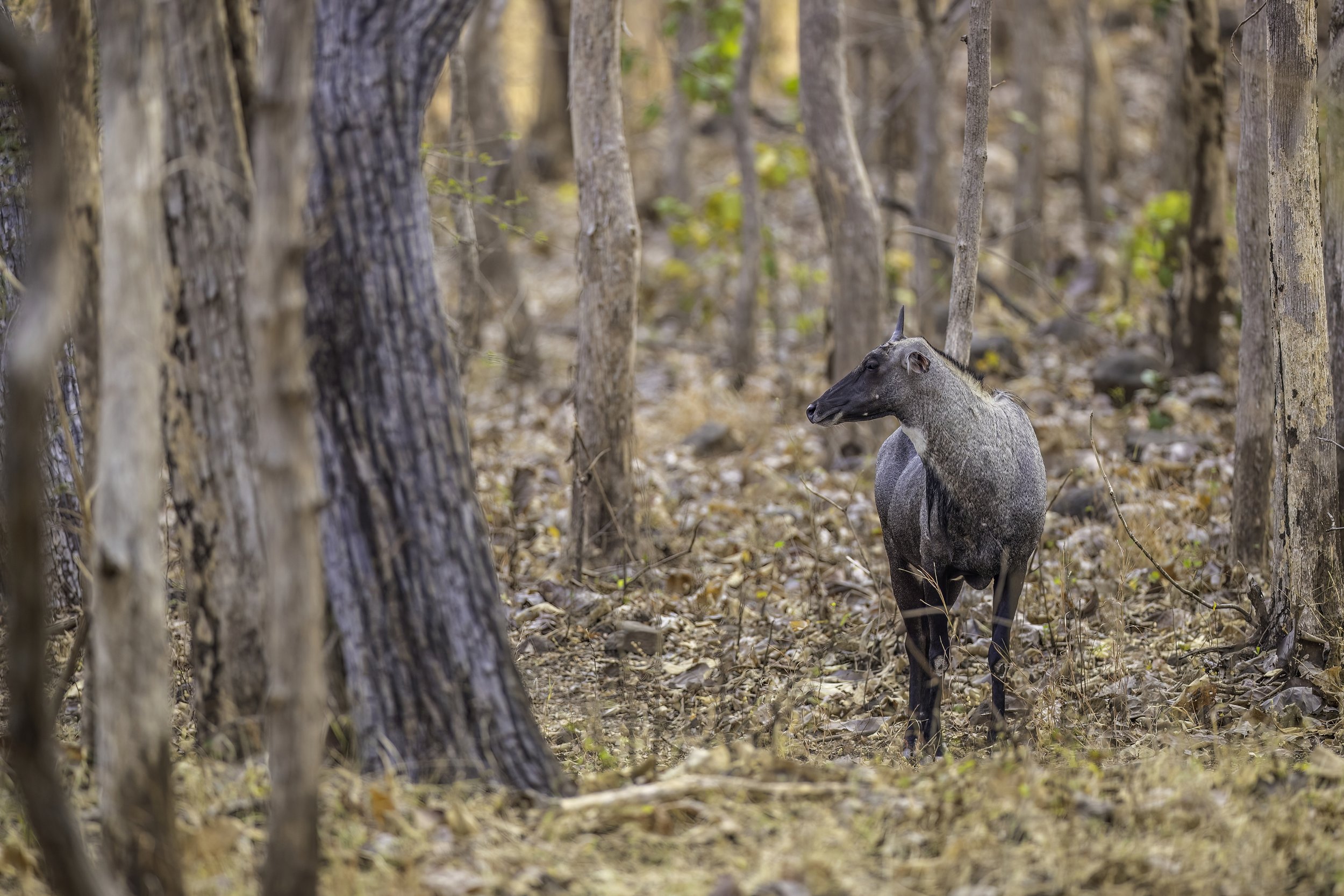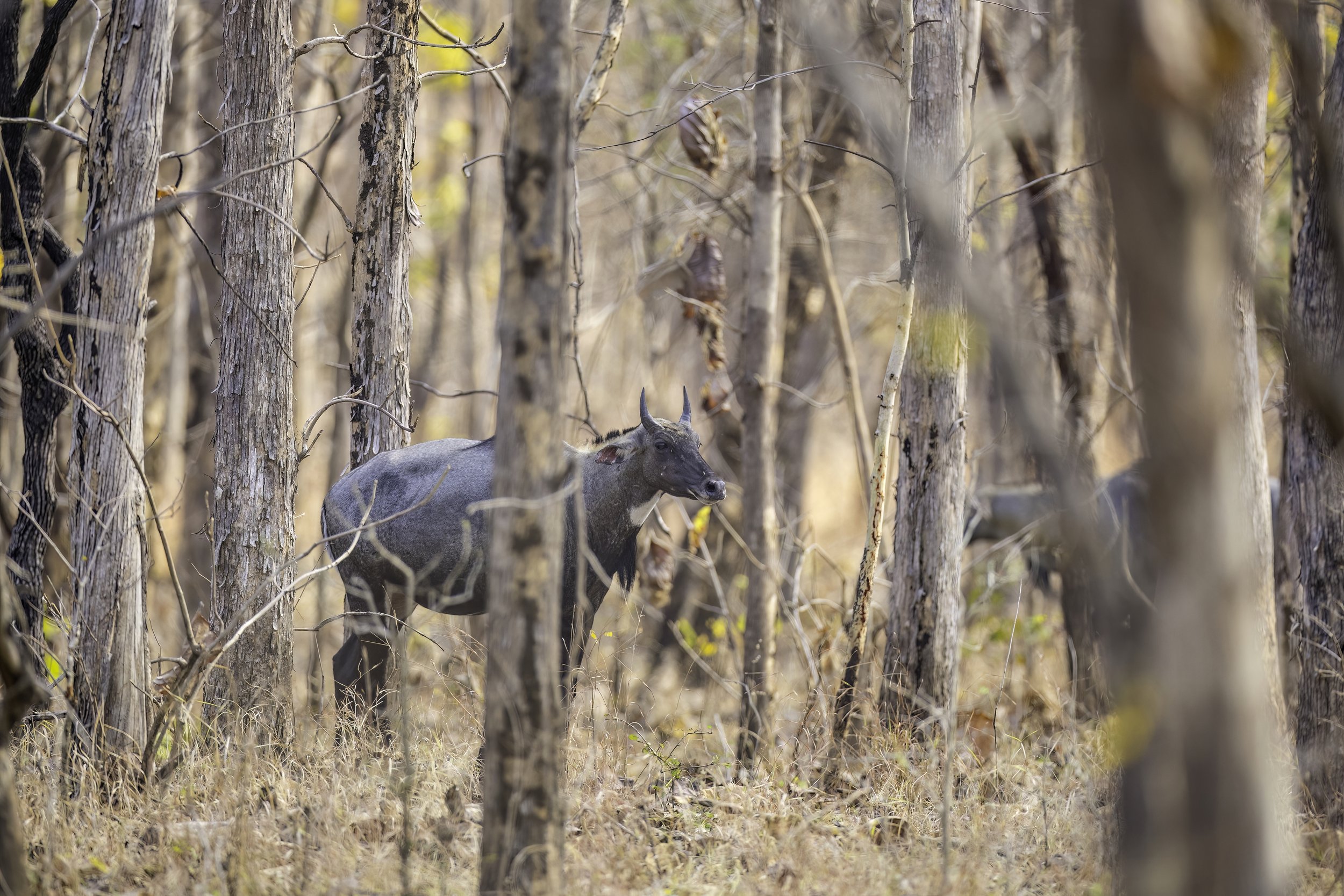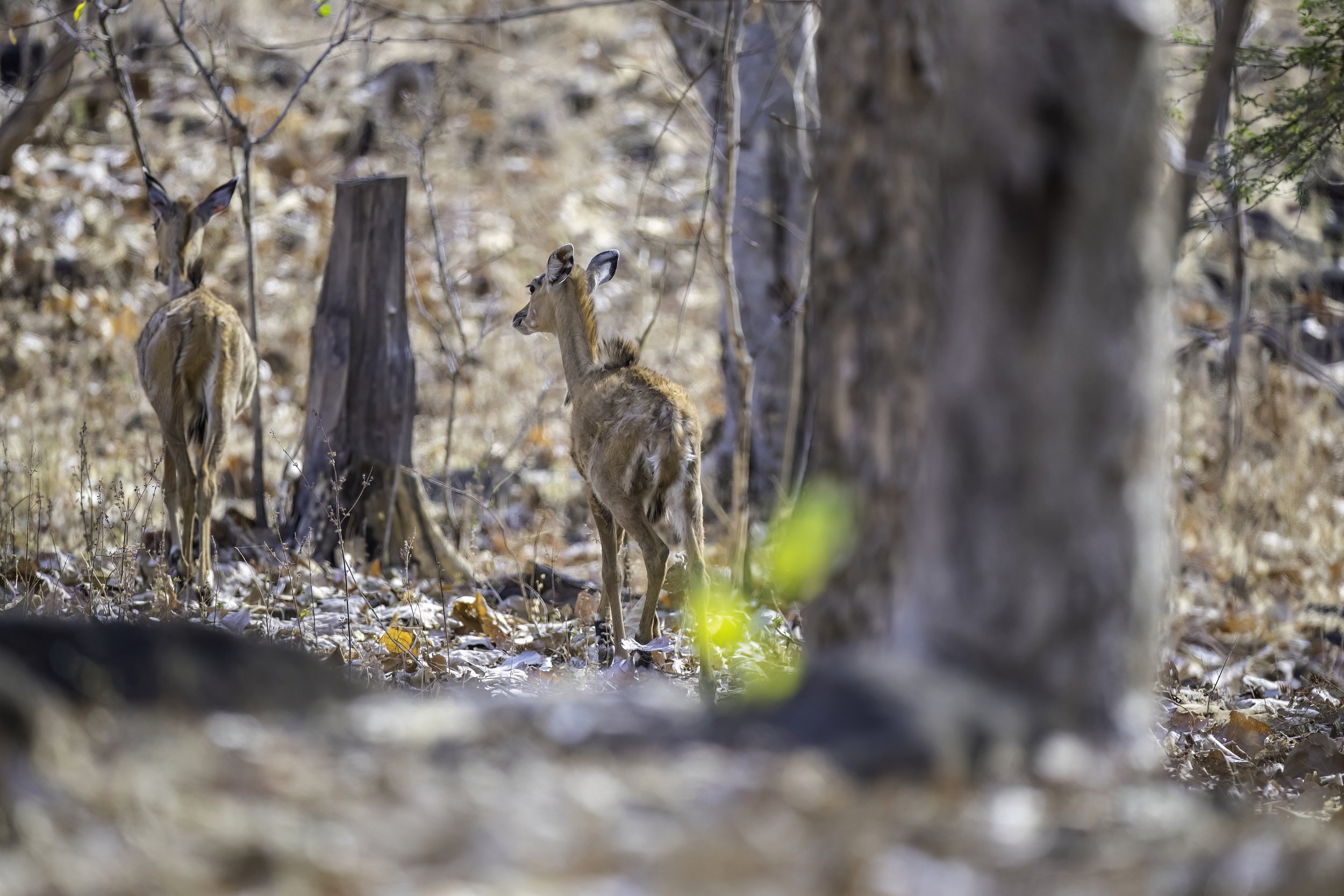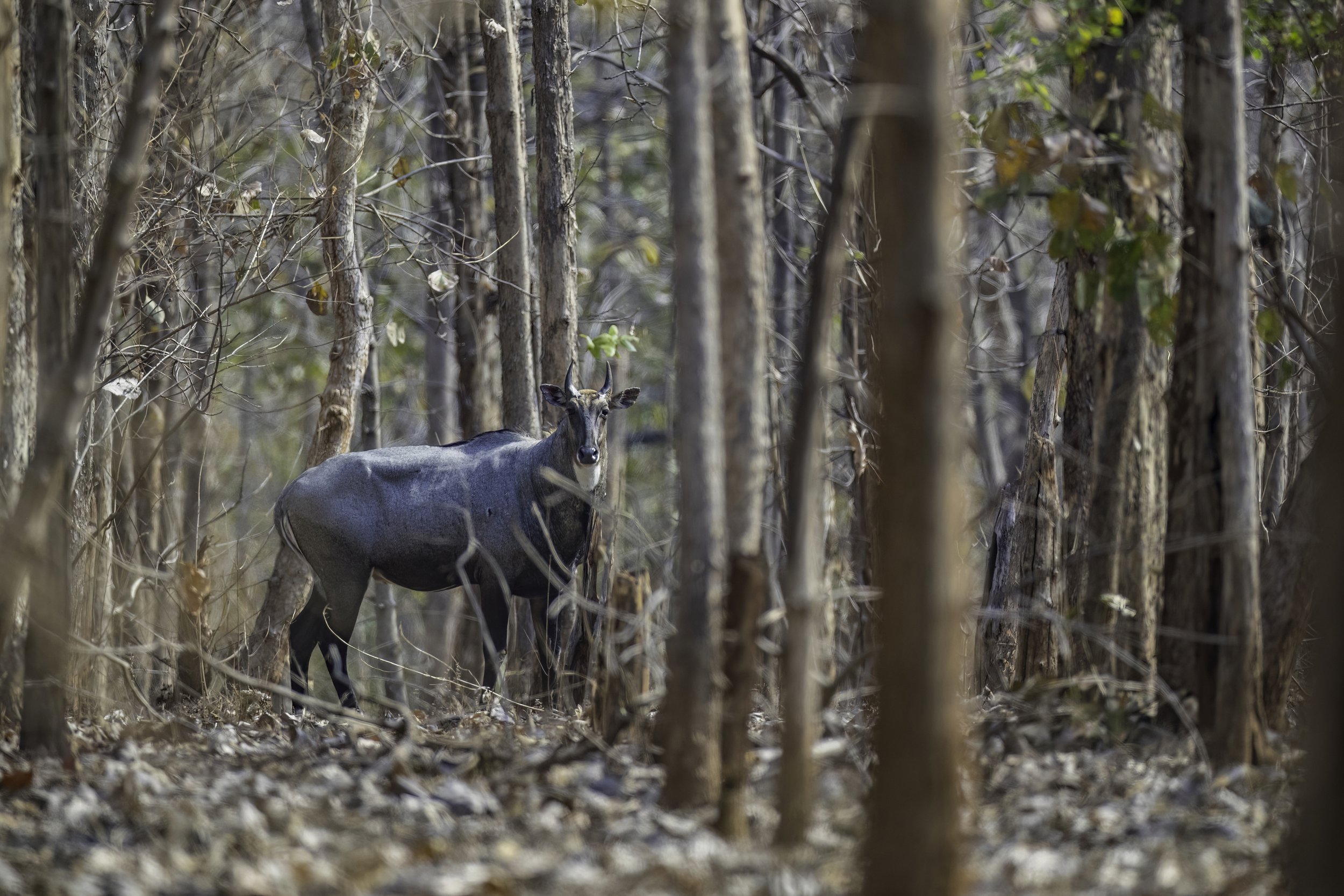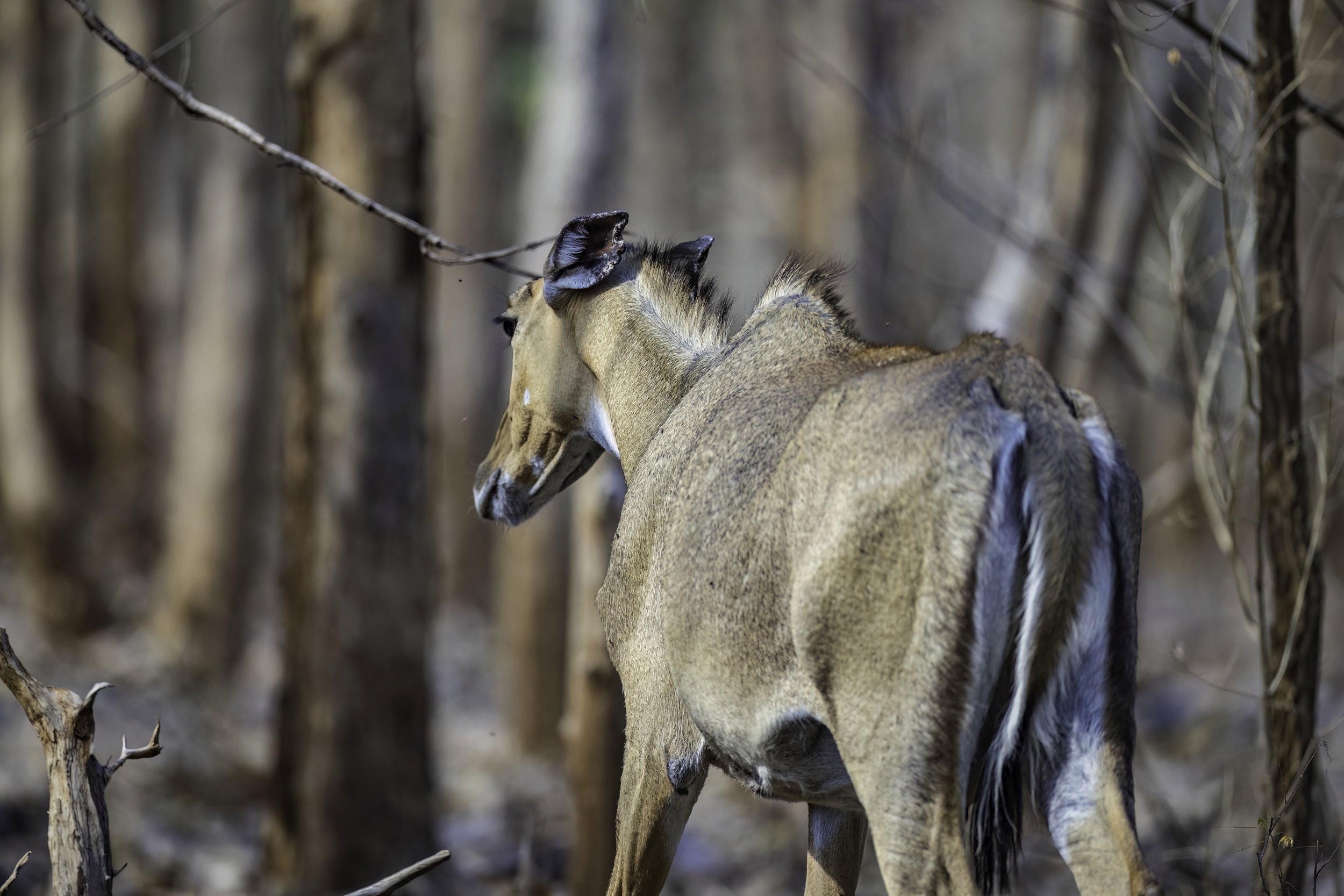Nilgai
Boselaphus tragocamelus
Tipeshwar Wildlife Sanctuary, Maharashtra
Central India is considered to be the heart of India’s wildlife. It is home to some of India’s largest forest tracts, rich wildlife as well as indigenous people who have been living in the forests since time immemorial. Located to the south of the Vindhya hill range, Central India is well known for its sal (Shorearobusta) forests, in fact the region is the meeting point of sal from the north & teak (Tectonagrandis) forests from the south. This landscape supports approx. 16% of the total population of tigers found in India, with some of the largest contiguous forested tracks connected through wildlife corridors. Some of the tiger reserves critical from a conservation standpoint in this landscape are Kanha, Satpuda, Pench, Melghat, Tadoba and Achanakmar.
This landscape is recognized as a region with one of the best potentials for long-term tiger conservation by the National Tiger Conservation Authority, Government of India. Every wildlife enthusiast, at some point, dreams of spotting a royal bengal tiger in the wild and there is no better place in India than this Central landscape with its numerous tiger sanctuaries of varying climes and terrain. But other than tiger (Panthera tigris), the faunal diversity includes some of the most charismatic and endangered species such as the leopard (Panthera pardus), dhole (Cuon alpinus), sloth bear (Melursus ursinus), gaur (Bos gaurus), nilgai (Boselaphus tragocamelus) - our focus today - and multiple species of deer as well as more than 300 species of birds. The Nilgai is the only antelope in the world whose back slopes to the rear.
Talking of birds, these Central Indian Forests have been defined by BirdLife International as an Endemic Bird Area as it includes the range of the critically endangered forest owlet. It encompasses the southern region of Madhya Pradesh, the Vidarbha region of Maharashtra and Chhattisgarh. This forest consists of dry deciduous trees and hosts many wildlife sanctuaries and national parks within for example the Kanha National Park, Pench National Park & Melghat Wildlife Sanctuary. The forest owlet was thought to be extinct but was rediscovered in Melghat.
The forests and wildlife of this landscape are threatened by encroachment, poaching of tigers and prey species, human wildlife conflict, unregulated and illegal cattle grazing, unsustainable harvesting of Non Timber Forest Produce (NTFP), medicinal plants & other forest resources, forest fires, mining & industrial development. And by the 1990s, much of the tiger population in India was wiped from almost all the wildlife reserves due to the exponential increase in human settlements inside and on the fringes of the forests. This led to a fragmentation of the forests and a breakdown of the corridors connecting the forested areas. One such fragment was the still relatively unknown Tipeshwar Wildlife Sanctuary, an isolated national park in the Yavatmal area along the borders of Telangana and Maharashtra. It lies in the Pandarkawada district of Yavatmal and stretches over an area of 148.63 sq.kms sprawling among the Patanbori and Parwa ranges of the Pandarkawad Forest Division. The sanctuary is a compact patch of dense forest cover with hilly undulating territory and various types of vegetation that varies with the altitude. It derives its name from the "‘Goddess Tipai” who is enshrined in a tiny temple on the hillside near the Tipeshwar Village within the sanctuary area just about 2kms from the Tipeshwar Forest Guest House.
Tipai Mata Temple
Tipeshwar Wildlife Sanctuary
Tipeshwar Wildlife Sanctuary has emerged as a successful tiger-cradle in the Eastern Vidarbha Landscape (one of the prominent Tiger Conservation Landscapes of India) and has demonstrated the potential to populate nearby tiger reserves like the Kawal Sanctuary in Telangana. However, like almost all other tiger reserves in India, Tipeshwar too, is plagued by the usual suspects – it is surrounded by densely populated and human dominated landscape with all the associated baggage that unhindered human activity brings - poaching, cattle grazing, trespassing etc., development – illegal mining, highway expansion etc., forest and prey-base degradation, human-tiger conflict etc. There are also a number of villages within the sanctuary area and their inhabitants are dependent on the forest for their livelihood.
But that said Tipeshwar has gone from being a sink, collecting surplus tigers from the larger sanctuaries, to becoming a source, generating increasing tiger numbers with village relocation playing a particularly important part. The three villages in the sanctuary - Tipeshwar, Pitapingri and Maregaon - mostly dominated by the Kolam tribe were relocated, I think, in 2014-15.
Five tribes occupy the Tipeshwar forest region viz., Pardhan, Gond, Kolam, Navbuddha & Kunbi, of which the former three are said to be aboriginal. The total populations of these tribes range from a few hundred to thousand and are seemingly vanishing; these tribes are stricken with poverty with a high mortality rate in infants, and a high incidence of sickle cell disease. Albeit in the recent years the increase in tourism has improved their condition to some degree.
The inviolate spaces created for the tigers through this village relocation exercise and additional measures such as the introduction of prey like sambar has helped the increase in the population of tigers. But on this trip, although we did see some tigers, I was entranced by the magnificence of the Nilgai. Their sheer size and grace needs to be observed to be believed. Here are some photographs I was able to gather of the Nilgai in Tipeshwar Wildlife Sanctuary.
Read about some of the tigers and the diverse wildlife inhabiting Tipeshwar Wildlife Sanctuary.
These two young bucks were play fighting just as we arrived and stopped to look at us and then very quickly disappeared uphill into the brush to the right of this frame. Photographed handheld on a cloudy afternoon around 3.45pm.
Exif: Canon 1Dx Mark ii + EF 600mm f/4; 1/1000; ISO 800; f/4
The Tipeshwar Sanctuary is also home to a number of rivers like Purna, Krishna, Bhima and Tapti which irrigate the sanctuary. This abundance of water gives the region the moniker - the Green Oasis of Maharashtra. The sanctuary area is primarily composed of basalt from some ancient lava eruptions and boasts immense diversity in both flora & fauna.
It is home to some 25 species of mammals, about 182 species of birds, 22 species of amphibians and numerous reptiles like the Indian Cobra, Indian Rock Python, Russel’s Viper & Checkered Keelback. And of these multitude of reptiles 6 are scarce species. Bengal Tigers, Leopard Cats, Sloth Bears, Indian leopards, Gaur, Dhole, Hyena, Chital, Black Buck, Sambar, Jackal, Wild boar, Peacock, Monkey, Nilgai & Wild Cats are some of the species seen in this sanctuary.
The Sanctuary is a compact patch of dense forest cover. The major forest type here is the ‘Southern Tropical Dry Deciduous Forest’ and Teak forms up to 60% of the forest composition. And as is the norm with central Indian forests one can also see the Achar (Cordia myxa), the Mahua (Madhuca longifolia), the Lendia (Lagerstroemia parviflora), Bhirra Tiwas (Ougeinia oojeinense) and several other types. Also, approximately 15% of this park consists of the Red Sandalwood (Pterocarpus santalinus), the costliest of all the sandalwoods in India.
There is also a wide variety of herbs and grasses including Kunda, Kadmod, Guhar, Wide, Gokru, etc. Over 250 species of Bamboo serve to make the sanctuary a repository of economical, medicinal, aromatic, and ornamental plant varieties. Bamboo groves dominate the undergrowth within the Teak dominated areas.
This then was the spectacular and dense habitat into which we ventured in search of tigers and the elusive Nilgai.
A huge bull photographed handheld just before 6am a few minutes after we entered the forest
Exif: Canon 1Dx Mark ii + EF 600mm f/4; 1/13; ISO 3200; f/4
Nilgai
The nilgai (Boselaphus tragocamelus), also called bluebuck and literally meaning "blue cow" is the largest antelope of Asia, indigenous to the Indian subcontinent, and Hindus accord it the same sacred status as cattle as both belong to the subfamily Bovinae. It is the sole member of the genus Boselaphus, which was first described by Peter Simon Pallas in 1766. The nilgai stands 3.3–4.9 ft at the shoulder; males weigh 109–288 kg, and the lighter females 100–213 kg. A sturdy thin-legged antelope, the nilgai is characterised by a sloping back, a deep neck with a white patch on the throat, a short crest of hair along the neck terminating in a tuft, and white facial spots. A column of pendant coarse hair hangs from the dewlap ridge below the white patch. Sexual dimorphism is prominent – while females and juveniles are orange to tawny, adult males have a bluish-grey coat. Only males possess horns, 15–24 cm long. The nilgai is the only one of the four Indian antelopes that is still abundant.
The nilgai is diurnal (active mainly during the day) banding together in three distinct kinds of groups: one or two females with young calves, three to six adult and yearling females with calves, and all-male groups with two to 18 members. Typically tame, the nilgai may appear timid and cautious if harassed or alarmed; it flees up to 300m (980 ft), or even 700m (2,300 ft), galloping away from the source of danger. Herbivores, nilgai prefer grasses and herbs, though they commonly eat woody plants in the dry tropical forests of India. Females become sexually mature by two years, while males do not become sexually active until four or five years old. The time of the year when mating takes place varies geographically, but a peak breeding season lasting three to four months can be observed at most places. Gestation lasts eight to nine months, following which a single calf (sometimes twins or even triplets) is born. As typical of several bovid species, nilgai calves stay hidden for the first few weeks of their lives. The lifespan of the nilgai is around ten years.
The nilgai prefers areas with short bushes and scattered trees in scrub forests and grassy plains. It is common in agricultural land, but rarely in dense forest. Major populations occur in the Indian and Nepal Terai. It was thought to be extinct in Bangladesh. The nilgai is categorised as Least Concern on the IUCN Red List.
The nilgai has been associated with Indian culture since the Vedic period (1500–500 BCE). They were hunted in the Mughal era (16th to 19th centuries) and are depicted in numerous miniatures. Nilgai have been considered a pest in several north Indian states, as they ravage crop fields and cause considerable damage. In Bihar, authorities have classified the nilgai as vermin.
The nilgai is endemic to the Indian subcontinent: major populations occur in India, Nepal and Pakistan. Significant numbers occur in the Terai lowlands in the foothills of the Himalayas; the antelope is abundant across northern India. It prefers areas with short bushes and scattered trees in scrub forests and grassy plains. They are common in agricultural lands, but hardly occur in dense woods. Though sedentary and less dependent on water, nilgai may desert their territories if all water sources in and around it dry up. The Indian population was estimated at one million in 2001.
Nilgai search for new areas if they run out of water
Population densities show great geographical variation across India. Density can be as low as 0.23 to 0.34 individuals per km2 in Indravati National Park and 0.4 individuals per km2 in the Pench Tiger Reserve, or as high as 6.6 to 11.36 individuals per km2 in Ranthambhore National Park, and seven individuals per km2 in Keoladeo National Park. Seasonal variations were noted in Bardiya National Park in a 1980 study; the density 3.2 individuals per km2 during the dry season and 5 per km2 in April, the start of the dry season.
Nilgai - Range & Distribution
Historic notes mention nilgai in southern India, but these may have been feral:
I believe that the Coimbatore and Salem collectorates are almost the only places in Southern India, in which nil-gai are to be found. It is difficult to account for the animals being thus so widely divided from their usual haunts unless as has been generally supposed, these Southern specimens are the progeny of a semi-domesticated herd, which, at some by-gone period, had escaped from the preserve of a native potentate.
— Andrew Cooke McMaster (Notes on Jerdon's Mammals of India, 1871)
The nilgai is categorised as of Least Concern by the International Union for the Conservation of Nature and Natural resources (IUCN). While it is common in India, the nilgai occurs sparsely in Nepal and Pakistan. The major reasons behind its decimation in these two countries are rampant hunting, deforestation and habitat degradation in the 20th century.
In India, the nilgai is protected under Schedule III of the Wildlife Protection Act of 1972. Major protected areas for the nilgai across India include: Gir National Park (Gujarat); Bandhavgarh National Park, Bor Wildlife Sanctuary, Kanha National Park, Pachmarhi Biosphere Reserve, Panna Tiger Reserve, Pench Tiger Reserve, Sanjay National Park, Satpura National Park (Madhya Pradesh); Tadoba Andhari Reserve (Maharashtra); Kumbhalgarh Wildlife Sanctuary, Sultanpur National Park in Gurgaon, Ranthambore National Park, Sariska Tiger Reserve (Rajasthan) and now Tipeshwar Wildlife Sanctuary.
During our trip we saw the nilgai on a daily basis both in the mornings and in the afternoons and magnificent specimens showcasing the health of the animals and the abundance of their food. This is the most I have seen the nilgai in all the forests they inhabit. I think the only time I saw something close to these numbers was in Ranthambore National Park quite a few years back. The second picture you see above was made as we entered the park from the Sunna Gate early in the morning just as it was starting to become light. On one outing as we were trying to track down the dominant male, Zanjeer, we spotted two young bucks play fighting. They stopped as they heard us approach and turned to look at us before making their way uphill into the dense brush.
I am grateful to the Forest Department and the entire team led by RFO Vivek Yewatkar for their help and insights. The RFO is seen in the photograph below in the center with his entire team. My heartfelt thanks to the team of guides, drivers and trackers who are knowledgable and ensured that our experience was absolutely amazing.
I am also grateful to Mr. Uday Krishna Peddireddi, Mr. Shiva Kumar and the entire Foxtail Eco Retreat team for hosting us and ensuring we had a fantastic stay. The Foxtail is a small rustic Eco Retreat a few meters from the Sunna Gate, Tipeshwar Wildlife Sanctuary. It has luxurious tents set against the backdrop of the dry deciduous jungle of Tipeshwar. Foxtail is not a place for “party” and “fun“ seekers It is a place of peace and tranquility and a medium to feel a sense of oneness with the surrounding jungles. True wildlife and nature lovers will absolutely cherish being here. Its close proximity to the jungle also allows the animals to wander through the property at night. We had the pleasure of spotting multiple herds of Nilgai and Chital grazing through the property on multiple occasions well after sunset. There are also two machans built which enable one to look out over a wider area of the jungle and if one is lucky sometimes a tiger wanders by. On my time up in the machan, with my wife, we saw and heard chital, sambhar and numerous peacock and I think some wild boar went by below us through the brush but were not visible from the machan. It was a spectacular moon lit night which made our time on the machan memorable. The fact that the Foxtail Retreat falls in a Bortle Class 3 (Read more about light pollution and Bortle Classes) ensured that the moonlight was brilliant and the lack of light pollution drastically improved our visibility of the stars.
Some fun facts
The name "nilgai" comes from the fusion of the Hindi words nil ("blue") and gai ("cow"). The word was first recorded in use in 1882.
The nilgai has a variety of names such as neelghae, nilgau, nilgo, nylghau, and nylghai, constructions referring to other "blue" animals. They are also known as White-footed antelope.
The coat of the nilgai is not well-insulated with fat during winter and severe cold might prove to be fatal.
The nilgai has been associated with Indian culture since the Vedic period (1500–500 BC). Hindus revere the nilgai as sacred and associate it with the cow, the mother animal in Hinduism, through its name and loosely similar physical features. The nilgai is rarely consumed by Hindus due to its religious significance and tribes such as the Bishnois traditionally take care of wild animals like the nilgai.
Tipeshwar Forest Department led by RFO Vivek Yewatkar
Pic Credit: Vivek Yewatkar
‡‡‡‡‡
To truly experience the jungle like I have done so many times before please close your eyes, imagine yourself on a machan in the darkness with only the moon for light, and listen to this recording of the jungle warning the approach of a tiger.
Understanding what animal calls mean can be hugely beneficial for a wildlife enthusiast, especially since the target subject is a lone master of disguise. When one is in a vast, dense jungle in India, and the tiger one hopes to document could be anywhere in that jungle, the only sense that can be relied on is hearing. Finding paw prints and signs of activity will show what happened on the night’s hunt, but once the animal vanishes into the tangled undergrowth the only way to track it is to stand and listen for a call. Not from the tiger itself, but an alarm call from potential prey alerting their fellow animals to the location of the predator. This is a phenomenon one has to experience, but first, what exactly is an alarm call?
Alarm calls are calls given by animals lower in the food chain, potential prey animals, when they detect the movement of an apex predator. Monkeys, deer and even birds give alarm calls. It is a very short, high pitched and high intensity call. When an apex predator, a tiger or a leopard, is spotted these alarm calls warn the herd that the predator is on the prowl. So when we hear these, we listen for the intensity, how far the call has come from and how reliable it is. What do I mean by reliable? One of the first and most useful vocal indicators are the Bandar Log - Hanuman Langurs, perched in the high branches able to see the predator from afar, who amazingly use a barking alarm call for leopards and a different call for tigers. Their call indicates that a predator is on the move and by finding the direction of their gaze the general direction of the predator can be gauged. Experienced guides can also determine, based on the intensity and tone of the call, whether the predator is a tiger or a leopard. Chital, favourite prey of tigers, quickly respond to the langurs call and begin a persistent barking of their own. And finally one of the most defined calls to listen for when tracking is given by sambar deer, who make a guttural squeak and stamp their feet when they spot the tiger. And when the tiger is out on the hunt this is an explosion of alarm calls from different animals that echoes through the jungle.
With that said hit play, close your eyes and listen to this recording from Tadoba from a few years back. It starts with a Langur hesitantly raising the alarm - maybe he has spotted those dreaded stripes whispering through the tall grass - the dappled light plays tricks. The call is then picked up by the chital and then almost a minute later, a sambhar! Now the tiger has definitely been spotted. The intensity grows, the chital, the sambhar call more fervently and then you hear it!
“One can hear a tiger roar from over a mile away!”
For more about all the tigers I have encountered click the button below
‡‡‡‡‡
Related Posts





